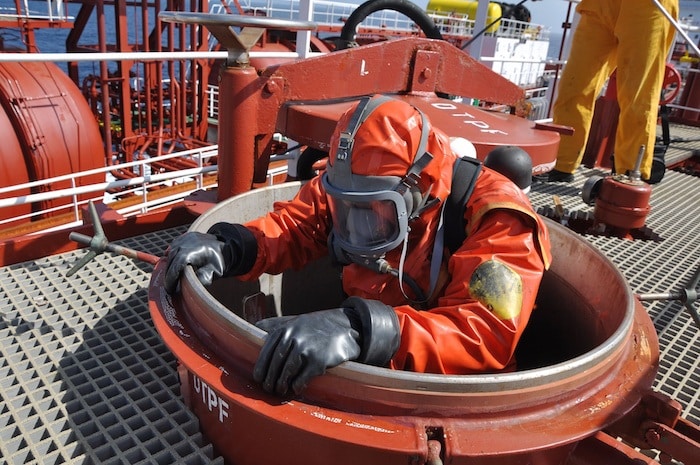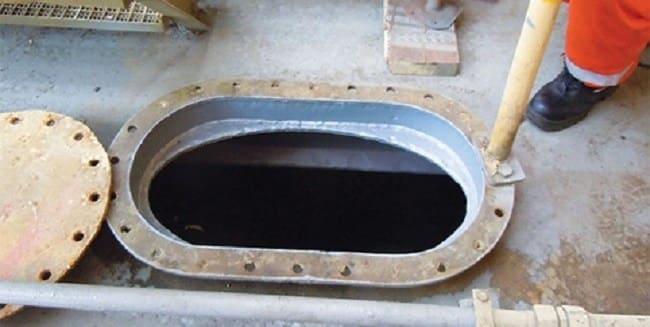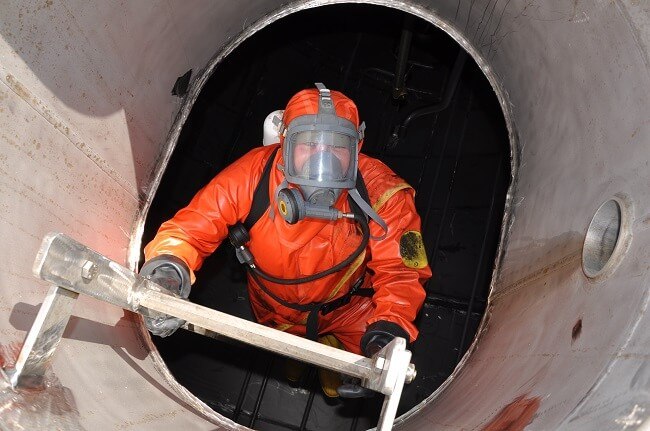

Tank cleaning is a common procedure performed on board ships. Those associated with the process are very well aware of the hazards involved and fatal accidents that have occurred in the past. In spite of all the necessary safety precautions and enclosed space entry procedures, accidents still occur while cleaning tanks on board ships.
Few months ago, a chief officer died on board a chemical tanker after he entered a cargo tank which contained hydrocarbon vapours and was deficient in oxygen. When the ship sailed at night after the cargo had been discharged, the two tanks that had carried hexene-1 were still inerted with nitrogen gas. As the tanks were to be loaded at the next port within two days, the crew began day/night tank cleaning operations soon after sailing. The chief mate was a non-watch keeper, so was able to direct the tank cleaning crew continuously. Early the next morning, during post-cleaning ventilation, the chief mate, who was preparing to conduct pre-loading inspection of the empty tanks, was informed that a ‘petrol-like’ odour was still coming from 5P tank. He had filled out the enclosed space entry checklists for the tanks he intended to enter that morning, but significantly, no enclosed space entry checklist was filled out for 5P tank.


Later that morning, when the master received an email from the ship’s agent requesting pre-arrival information, he was unable to locate the chief mate. Eventually, his lifeless body was located slumped at the bottom of 5P tank. A rescue team donned BA sets and after carrying out tank entry checks, pulled out the officer and moved him to the upper deck. It was noted that the oxygen content of the atmosphere inside the tank varied between 12 per cent and 16 per cent. Continuous resuscitation efforts were made until the arrival of a helicopter with shore medical personnel, who soon declared that the chief mate was dead. The next day, the vessel arrived at her destination and the chief mate’s body was landed.
Unfortunate accidents like above are still common on ships, mainly due to sheer carelessness of crew members. While it is the responsibility of the master of the vessel or officer in charge to carry out the tank cleaning procedures safely and in accordance with company’s safety procedure manual and other safety guidelines available, it is the duty of every person on board to ensure his and his crew members safety.
Before making an entry for tank cleaning, ensure to
Once the tank is found suitable for man entry, a detailed plan for carrying out the work is to be laid out, like the duration of work to be carried out, persons entering the tank for cleaning, person in charge etc. This will help in completing the given work safely and without any unwanted delay.
Related Reading:
Mentioned below are eleven points that must be followed while carrying out tank cleaning on ships.
1. Never Enter Without Personal Protective Equipment: Person entering the tank should always wear proper personal protective equipment while entering enclosed spaces. Entering a confined space like ballast tank or fuel tank will be a challenging task with all PPE donned, especially with helmets on, but that shouldn’t be an excuse for not wearing PPE. But it is a good practice not to neglect the basic safety procedures, even though the working place is considered to be more comfortable and safe.
2. Take All Equipment And Tools Required: Take all necessary equipment and tools required for work such as rags, buckets, scoops, water etc. The number of persons entering the tank should be minimal for quick rescue operation in case of any emergency. A person should be readily available at the opening to pass tools required or to collect the wastes etc. As the time for enclosed space entry is limited, make sure you do not waste time searching or asking for tools after making an entry. Finish the work and get out as soon as possible.
3. Illuminate the Tank Properly: The tank where the work is under progress should be well illuminated. For this flame proof lamps must be used. Care must be taken that the the wire used for connection is broken and does not have loose connections. The lamps used should have hook or other provision attached to secure them on right place during work. Do not take any kind of lights which can become a source of fire.
4. Communicate Frequently: While cleaning, the person outside the tank should make sure that people working inside the tank are safe and sound. This is done by frequent communication just by voice or through VHF if provided, especially while working inside the tanks where presence of toxic gases is absolute.
5. Take Breaks: Do not work inside the tank continuously. Take break at regular intervals. This might slow down the cleaning process but, nonstop work can be achieved by rotating the person involved. When a person comes out of the tank to take a break, another person can go in to continue the work. Because cleaning doesn’t require much skill like welding or any other work, it can be properly shared between crew members.


6. Ensure Breathing Air Is Supplied Without Hindrance: If work is carried out by wearing breathing apparatus, where continuous supply of air is provided from air bottles from engine room, engineer on watch is to be informed regarding the time and place of the work being carried out. The hoses should be checked well before entering the tank for any damage and leakage near the facemask. A person should make sure the air is supplied without any hindrance. Also, spare charged oxygen cylinders to be kept outside the tank for emergency or reuse.
7. Display Placards On Valves/Pumps: Placards showing precaution notices are to be placed near the valves and pumps, which are connected to the tank where the work is under progress to avoid any accidental operation. ECR and CCR are provided with whiteboard. A note of tank cleaning operation in progress can be written over the board for general awareness.
8. Handle Chemicals With Extra Care: Extra precautions should be taken where the cleaning involves use of any chemicals. The chemicals should be handled as per Material safety data sheet (MSDS). First aid kit and medicines should be kept ready for immediate use. It is important that crew members should know which chemical to be used for different tank cleaning. For e.g. A fuel tank cleaning will require a stronger cleaning agent but for cleaning bilge tank in the engine room, only OWS friendly chemicals to be used.
9. Different Tanks Requires Different Cleaning Operations: A ship comprises of several tanks which holds various types of liquid inside it. Cleaning a fuel oil tank will require more man power and different safety precautions, including shutting of steam in the heating coils. Similarly, cleaning of fresh water tank requires entirely different approach with minimum crew for cleaning the F.W tank, for e.g. the crew going inside the tank should not have any skin infection or disease and should not wear regular footwear while entering the tank.
10. Stop Work If It Exceeds Time Limit: The work should be stopped if it exceeds the time limit mentioned on work permit. Work has to start again only after issuing new permit to work. Even though the tank is continuously ventilated, it is best practice to check the space randomly for oxygen level and presence of any toxic gases. If the person inside the tank feels uncomfortable inform the person outside and exit the tank without delay. All necessary means for rescue operation should be kept ready.


11. Clear The Area Without Missing Anything: Once the work is completed, remove all the tools, lamps and rags used. Remove all wastes and any water accumulated as far as practicable. Rags left behind can choke the pipe lines and will lead to another prolonged and time consuming process.
Officer responsible for tank cleaning procedures should make a proper risk assessment taking in to account the danger involved to life and property and the same has to be recorded.
All persons entering the tank should be briefed about the risks involved, means of rescue procedures, use and donning of breathing apparatus etc.
Do not enter the tank without filling and signing the permit to work. Permit to work should not be considered just as another paper to be filed; instead all the precautions and safety measures mentioned on them should be implemented to carry out the work safely.
If any accident/ hazard has occurred or likely to occur, an incident form and near miss form is to be filled giving details of the nature of hazard occurred or would have happened for future reference, to minimize the risk and to improve the safety precautions to be taken.
Over To You..
Can you suggest us more practical points to be considered while cleaning tanks on board ships? Let’s know in the comments below.










We believe that knowledge is power, and we’re committed to empowering our readers with the information and resources they need to succeed in the merchant navy industry.
Whether you’re looking for advice on career planning, news and analysis, or just want to connect with other aspiring merchant navy applicants, The Marine Learners is the place to be.